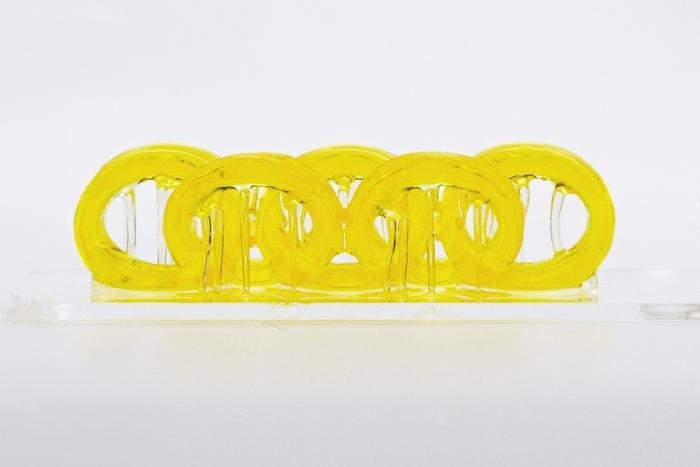A new 3D printing technique developed at the University of Texas at Austin uses different light colors to fuse soft and hard materials into a single object, mimicking the flexibility and strength found in natural tissues.

The result of a new method for printing objects using novel resins to provide flexibility, strength, and complexity similar to nature. Image Credit: The University of Texas at Austin.
The process, described in the journal Nature Materials, offers a fast and accurate way to integrate contrasting material properties in a single print. It could enable the creation of devices that flex and stretch like human joints or skin, all built using relatively simple and accessible equipment.
The researchers formulated a liquid resin inspired by the way nature combines rigid and pliable components like bone and cartilage. They combined it with a specially designed dual-light printing system. By switching between violet and ultraviolet light, they could solidify the liquid resin into either a flexible or rigid form.
What really motivated me and my research group is looking at materials in nature. Nature does this in an organic way, combining hard and soft materials without failure at the interface. We wanted to replicate that.
Zak Page, Assistant Professor and Study Corresponding Author, Chemistry, University of Texas at Austin
This approach could make additive manufacturing more competitive for higher-volume production compared with traditional processes like injection molding. Just as important, it opens up new design possibilities. This gives engineers, designers, and makers more freedom to create.
Keldy Mason, Study Lead Author and Graduate Student, University of Texas at Austin
To test the system, the team printed a miniature knee joint with flexible ligaments and rigid bones. It moved together smoothly, demonstrating the 3D printing method's capabilities. They also developed a prototype electronic device with a gold wire embedded in material that could bend in some places while remaining firm in others, which helped to prevent circuit failure.
The study also addresses a common problem in mixed-material products: different parts often separate or degrade at the point they meet. For example, when the sole of a trainer detaches from the rest of the shoe. The new approach makes those joints much more durable.
We built in a molecule with both reactive groups so our two solidification reactions could ‘talk to each other’ at the interface. That gives us a much stronger connection between the soft and hard parts, and there can be a gradual transition if we want.
Honestly, what surprised me most was how well it worked on the first try. That almost never happens with 3D printing resins. We were also shocked by how different the properties were. The soft parts stretched like a rubber band and bounced back. The hard parts were as strong as plastics used in consumer products.
Zak Page, Assistant Professor and Study Corresponding Author, Chemistry, University of Texas at Austin
Alongside improved performance, the team's 3D printing method is faster and delivers finer detail than existing techniques. The team believes the simplicity of the setup means it could be used not just in labs, but also in hospitals, schools, and design studios.
It could be used to prototype surgical models, wearable sensors, or even soft robots. There is so much potential here.
Zak Page, Assistant Professor and Study Corresponding Author, Chemistry, University of Texas at Austin
Journal Reference:
Kim, J.-W., et al. (2025) Hybrid epoxy–acrylate resins for wavelength-selective multimaterial 3D printing. Nature Materials. doi.org/10.1038/s41563-025-02249-z.